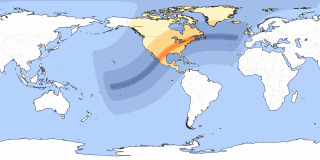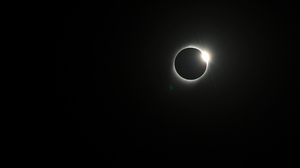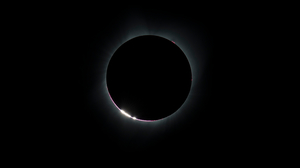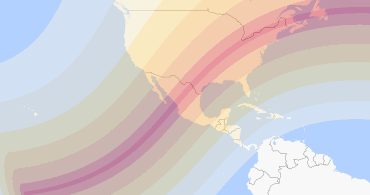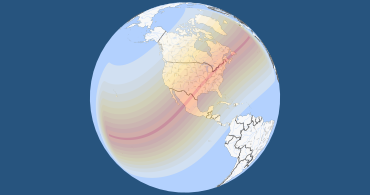Partial eclipse begins The moment the edge of the Moon touches the edge of the Sun is called first contact.
Totality begins The moment the edge of the Moon covers all of the Sun is called second contact.
Maximum eclipse The deepest point of the eclipse, with the Sun at its most hidden.
Totality ends The moment the edge of the Moon exposes the Sun is called third contact.
Partial eclipse ends The edge of the Moon leaves the edge of the Sun.
Dark shadow on horizon The Moon’s umbral shadow may become visible as it approaches from the west.
Corona appears The corona—the outer part of the Sun’s atmosphere—starts to become visible.
Dark shadow sweeps in The Moon’s umbral shadow arrives from the west and envelops the surroundings.
Diamond ring The corona forms a ring around the dark Moon, while the Sun dazzles like a jewel.
A jewel in the sky Read more about the diamond ring.
Baily’s beads Just before totality, beads of sunlight stream through valleys along the edge of the Moon.
Sunlight through valleys Read more about Baily’s beads.
Baily’s beads Just before annularity, beads of sunlight stream through valleys along the edge of the Moon.
Sunlight through valleys Read more about Baily’s beads.
Annularity begins The moment the Sun forms a ring around the Moon is called second contact.
Ring of fire The Sun shines as a dazzling annulus (a ring shape) around the Moon.
Chromosphere The chromosphere—a thin, red layer of the Sun’s atmosphere—is briefly visible.
Prominences Reddish, tounge-like prominences may poke out from the Sun during totality.
Corona During totality, the ghostly corona shines as brightly as a Full Moon.
Chromosphere Just before the end of totality, the chromosphere briefly reappears.
Annularity ends The moment the Sun’s ring around the Moon is broken is called third contact.
Baily's beads A new set of Baily’s beads appears, signalling the end of annularity.
Baily’s beads A new set of Baily’s beads appears, signalling the end of totality.
Diamond ring Baily’s beads come together to form another dazzling jewel of sunlight.
Dark shadow sweeps out The Moon’s umbral shadow departs toward the east.
Corona fades The ring of the corona around the Moon disappears from view.
Dark shadow on horizon The Moon’s umbral shadow may be visible in the distance as it retreats to the east.
Maximum eclipse The deepest point of the eclipse, with the Sun at its most hidden.
Maximum eclipse The deepest point of the eclipse, with the Sun at its most hidden.
Partial eclipse begins The moment the edge of the Moon touches the edge of the Sun is called first contact.
Partial eclipse begins The moment the edge of the Moon touches the edge of the Sun is called first contact.
Partial eclipse ends The moment the edge of the Moon leaves the edge of the Sun is called fourth contact.
Partial eclipse ends The moment the edge of the Moon leaves the edge of the Sun is called fourth contact.
Sunrise The sun is rising.
Sunrise The sun is rising.
Sunrise The sun is rising.
Sunset The sun is setting.
Sunset The sun is setting.
Sunset The sun is setting.
Temperature changes As the Moon covers the Sun, the amount of solar energy decreases.
Temperature changes As the Moon covers the Sun, the amount of solar energy decreases.
Temperature changes As the Moon covers the Sun, the amount of solar energy decreases.
Sharp & blurry shadows Shadow edges that are aligned with the Sun’s narrowing crescent become sharper.
Sharp & blurry shadows Shadow edges that are aligned with the Sun’s narrowing crescent become sharper.
Sharp & blurry shadows Shadow edges that are aligned with the Sun’s narrowing crescent become sharper.
Brightness of sky As the eclipse progresses, the sky starts to become noticeably darker.
Brightness of sky As the eclipse progresses, the sky starts to become noticeably darker.
Brightness of sky As the eclipse progresses, the sky starts to become noticeably darker.
Temperature, humidity & wind Conditions continue to change as the amount of solar energy decreases.
Temperature, humidity & wind Conditions continue to change as the amount of solar energy decreases.
Temperature, humidity & wind Conditions continue to change as the amount of solar energy decreases.
Light levels & colors Surroundings start to darken, while colors start to turn grayish.
Light levels & colors Surroundings start to darken, while colors start to turn grayish.
Light levels & colors Surroundings start to darken, while colors start to turn grayish.
Reaction of nature The behavior of animals and plants starts to be affected by falling levels of light.
Reaction of nature The behavior of animals and plants starts to be affected by falling levels of light.
Reaction of nature The behavior of animals and plants starts to be affected by falling levels of light.
Shadow bands Faint waves of light may be seen moving across the ground and walls.
Nature returns to normal Animals and plants are going back to their usual behavior.
Nature returns to normal Animals and plants are going back to their usual behavior.
Nature returns to normal Animals and plants are going back to their usual behavior.
Light levels & temperature The conditions of the sky and surroundings are returning to normal.
Light levels & temperature The conditions of the sky and surroundings are returning to normal.
Light levels & temperature The conditions of the sky and surroundings are returning to normal.
Shadow bands Faint waves of light may reappear along the ground and walls.
Moon bites Sun Using eclipse glasses, the eclipse starts to become visible to the eye.
Moon bites Sun Using eclipse glasses, the eclipse starts to become visible to the eye.
Moon bites Sun Using eclipse glasses, the eclipse starts to become visible to the eye.
Obscuration around 20% One-fifth of the area of the Sun’s disk is covered by the Moon.
Obscuration around 20% One-fifth of the area of the Sun’s disk is covered by the Moon.
Obscuration around 20% One-fifth of the area of the Sun’s disk is covered by the Moon.
Obscuration around 20% One-fifth of the area of the Sun’s disk is covered by the Moon.
Obscuration around 20% One-fifth of the area of the Sun’s disk is covered by the Moon.
Obscuration around 20% One-fifth of the area of the Sun’s disk is covered by the Moon.






